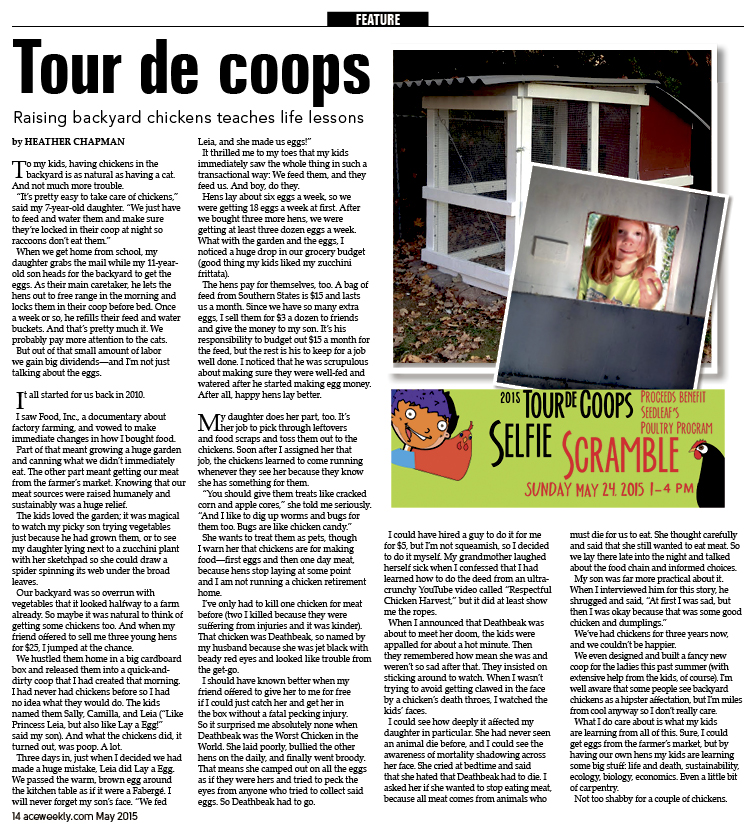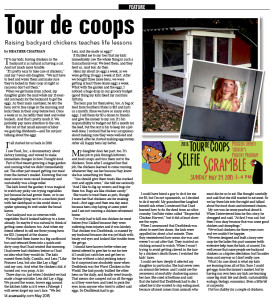To my kids, having chickens in the backyard is as natural as having a cat. And not much more trouble.
“It’s pretty easy to take care of chickens,” said my 7-year-old daughter. “We just have to feed and water them and make sure they’re locked in their coop at night so raccoons don’t eat them.”
When we get home from school, my daughter grabs the mail while my 11-year-old son heads for the backyard to get the eggs. As their main caretaker, he lets the hens out to free range in the morning and locks them in their coop before bed. Once a week or so, he refills their feed and water buckets. And that’s pretty much it. We probably pay more attention to the cats.
But out of that small amount of labor we gain big dividends—and I’m not just talking about the eggs.
It all started for us back in 2010.
I saw Food, Inc., a documentary about factory farming, and vowed to make immediate changes in how I bought food.
Part of that meant growing a huge garden and canning what we didn’t immediately eat. The other part meant getting our meat from the farmer’s market. Knowing that our meat sources were raised humanely and sustainably was a huge relief.
The kids loved the garden; it was magical to watch my picky son trying vegetables just because he had grown them, or to see my daughter lying next to a zucchini plant with her sketchpad so she could draw a spider spinning its web under the broad leaves.
Our backyard was so overrun with vegetables that it looked halfway to a farm already. So maybe it was natural to think of getting some chickens too. And when my friend offered to sell me three young hens for $25, I jumped at the chance.
We hustled them home in a big cardboard box and released them into a quick-and-dirty coop that I had created that morning. I had never had chickens before so I had no idea what they would do. The kids named them Sally, Camilla, and Leia (“Like Princess Leia, but also like Lay a Egg!” said my son). And what the chickens did, it turned out, was poop. A lot.
Three days in, just when I decided we had made a huge mistake, Leia did Lay a Egg. We passed the warm, brown egg around the kitchen table as if it were a Fabergé. I will never forget my son’s face. “We fed Leia, and she made us eggs!”
It thrilled me to my toes that my kids immediately saw the whole thing in such a transactional way: We feed them, and they feed us. And boy, do they.
Hens lay about six eggs a week, so we were getting 18 eggs a week at first. After we bought three more hens, we were getting at least three dozen eggs a week. What with the garden and the eggs, I noticed a huge drop in our grocery budget (good thing my kids liked my zucchini frittata).
The hens pay for themselves, too. A bag of feed from Southern States is $15 and lasts us a month. Since we have so many extra eggs, I sell them for $3 a dozen to friends and give the money to my son. It’s his responsibility to budget out $15 a month for the feed, but the rest is his to keep for a job well done. I noticed that he was scrupulous about making sure they were well-fed and watered after he started making egg money. After all, happy hens lay better.
My daughter does her part, too. It’s her job to pick through leftovers and food scraps and toss them out to the chickens. Soon after I assigned her that job, the chickens learned to come running whenever they see her because they know she has something for them.
“You should give them treats like cracked corn and apple cores,” she told me seriously. “And I like to dig up worms and bugs for them too. Bugs are like chicken candy.”
She wants to treat them as pets, though I warn her that chickens are for making food—first eggs and then one day meat, because hens stop laying at some point and I am not running a chicken retirement home.
I’ve only had to kill one chicken for meat before (two I killed because they were suffering from injuries and it was kinder). That chicken was Deathbeak, so named by my husband because she was jet black with beady red eyes and looked like trouble from the get-go.
I should have known better when my friend offered to give her to me for free if I could just catch her and get her in the box without a fatal pecking injury. So it surprised me absolutely none when Deathbeak was the Worst Chicken in the World. She laid poorly, bullied the other hens on the daily, and finally went broody. That means she camped out on all the eggs as if they were hers and tried to peck the eyes from anyone who tried to collect said eggs. So Deathbeak had to go.
I could have hired a guy to do it for me for $5, but I’m not squeamish, so I decided to do it myself. My grandmother laughed herself sick when I confessed that I had learned how to do the deed from an ultra-crunchy YouTube video called “Respectful Chicken Harvest,” but it did at least show me the ropes.
When I announced that Deathbeak was about to meet her doom, the kids were appalled for about a hot minute. Then they remembered how mean she was and weren’t so sad after that. They insisted on sticking around to watch. When I wasn’t trying to avoid getting clawed in the face by a chicken’s death throes, I watched the kids’ faces.
I could see how deeply it affected my daughter in particular. She had never seen an animal die before, and I could see the awareness of mortality shadowing across her face. She cried at bedtime and said that she hated that Deathbeak had to die. I asked her if she wanted to stop eating meat, because all meat comes from animals who must die for us to eat. She thought carefully and said that she still wanted to eat meat. So we lay there late into the night and talked about the food chain and informed choices.
My son was far more practical about it. When I interviewed him for this story, he shrugged and said, “At first I was sad, but then I was okay because that was some good chicken and dumplings.”
We’ve had chickens for three years now, and we couldn’t be happier.
We even designed and built a fancy new coop for the ladies this past summer (with extensive help from the kids, of course). I’m well aware that some people see backyard chickens as a hipster affectation, but I’m miles from cool anyway so I don’t really care.
What I do care about is what my kids are learning from all of this. Sure, I could get eggs from the farmer’s market, but by having our own hens my kids are learning some big stuff: life and death, sustainability, ecology, biology, economics. Even a little bit of carpentry.
Not too shabby for a couple of chickens.
This article appears on page 14 of the May 2015 print issue of Ace. Click here for info on the 2015 Tour De Coops.
For more Lexington, Kentucky arts, food, culture, and entertainment news, click here to subscribe to the Ace digital e-dition, emailed to your inbox every Thursday morning.










